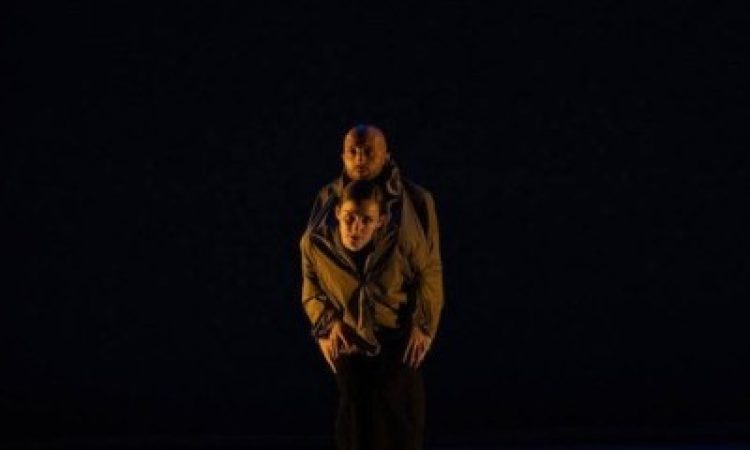The stage is dark. A soft Italian song, Una ragione di più, opens the performance of XY. The low, graceful voice is increasingly disrupted by radio static, blinking camera flashlights, and intertwining two mini-LED red lights. The red lights wave intensely to the buzzing radio like a mating dance between two fireflies. With the fading of the sound, the red lights disappear, and two dimly lit dancers look into each other’s eyes.
One male and one female wear baggy mustard jackets over tight black shirts and pants. The androgynous nature of their costume and the constant morphing of their power dynamic challenge the traditional gender binary. This hour-long duet, XY, is choreographed by Chinese-American artist and choreographer Xiang Xu and the associate Korean-American choreographer Heidi Yu in collaboration with New York-based Italian dancer Jonathan Colafrancesco and American dancer Gabrielle DiNizo. As Jonathan says during the talkback, the intersection of four cultures in the choreography creates a unique and engaging transnational experience. Moreover, the song at the beginning and his singing in his mother tongue during the duet evoke nostalgia and allow him to express his personal voice.
Although titled after the sex-determination chromosomes X and Y, the interaction between the dancers complicates the duality and gender stereotypes associated with men and women. To soft electronic music, Gabrielle, clad in her black costume, runs toward Jonathan, still in his floppy jacket. Standing behind him, she seizes his arms, forcefully lifting him from kneeling to an unsteady run. She then deftly catches his forehead and, with a deliberate yet commanding push, guides him back to the center stage. She extends her arms through his sleeves, slipping in to share the jacket. Amidst the now swirling Middle Eastern flute music and Arabic chanting, the two dancers’ bodies meld within the loose confines of the jacket.
At the talkback session, Gabrielle describes her connection with Jonathan in the duet as a “flow relationship,” not only attached to romantic heterosexuality but sometimes evoking emotional intimacy akin to that between a mother and son. The closeness of the two dancers’ bodies within the jacket accentuates the expressiveness of their heads and hands. One next to the other, facing the audience, their heads consistently sway from side to side or move up and down and create the mesmerizing illusion that they are detached. The dazzling intertwining of their hands within the jacket sleeves further blurs the distinctions of X and Y identification, emphasizing a harmonious collaboration while challenging the independence of human bodies.
Beyond the pivotal role of the costume, the hybrid music from diverse cultures and a large polyethylene sheeting in the backdrop serve as performative elements, enriching the labor of the moving bodies. In the midst of the dance, the transparent sheet transforms into a suspended ceiling, tethered by four descending strips at its edges. It refracts the blue, coral, and amber-colored stage lights, creating a visual spectacle resembling the dancers traversing undersea. Underneath the jellyfish-like entity, the dancers strip off their jackets and synchronously take big steps across the floor. They freely fan their arms like windmills while traversing the space with intense jumps and turns, as if swimming underwater. The music changes again, this time to soft, melodious piano and electronic beats, and the dancers’ bodies merge back into one jacket, their fingers interlocking within the sleeves. They slowly walk in this position below the floating ceiling.
In the finale, the polyethylene sheet descends, enveloping the embracing duet on stage. As the stage gradually darkens, a dancer (played by Xiang) wearing the same yellow jacket with a hoody covering his head enters the space. He carries a vintage radio cassette recorder emitting a static that echoes the opening sound of the performance. As the stage plunges into darkness, the dancers disappear, leaving only two mini-red beams buzzing in the obscurity.
For me, the masterpiece directed by Xiang is a visual, aural, and emotional feast of postmodern interculturalism. While danced by only two dancers, the polyphonic music, innovative stage setting, and the mix of English, Italian, and Iranian languages in the voiceover allow the audience to experience a complex drama in theatre. As Xiang says in the Q&A session, “I don’t like to categorize my identity within a box.” Through his collaboration with Heidi, Gabrielle, and Jonathan, Xiang has learned and engaged with artists from diverse cultural backgrounds. He invites his audiences to “embark on a voyage of self-discovery and introspection.”
XY, Xiang Xu, and Heidi Yu, Aaron Davis Hall, New York, Nov. 16 and 17.






